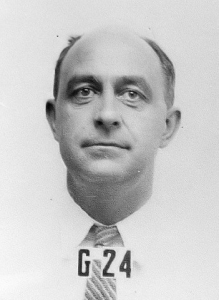SciTech Tuesday: Dangerous Experiments
Some people can get away with anything. Including two physicists, refugees from Axis powers, working on research for the Manhattan project. Today if you built a reactor beneath a football field, or stacked blocks of Uranium until they were about to go critical, you’d get in trouble. Instead, these guys got scientific fame.
Otto Frisch was an Austrian of Jewish ancestry. His aunt was Lise Meitner (she will be the subject of a later post). In 1933 Frisch moved first to England and then Copenhagen, where he worked with Nils Bohr. For the winter holidays of 1938, Frisch visited his aunt Lise Meitner, in Sweden, where she was working. He was with her when she hypothesized that the results of an experiment conducted in Berlin, in which atoms of Uranium were bombarded with protons, showed the fission of the nucleus. When he returned to Copenhagen, Frisch replicated the experiment and verified the process of nuclear fission. In the summer of 1939 Frisch traveled to England for what he thought would be a short trip. Moved by the start of hostilities, he worked with Rudolf Peierls to lay out a theoretical process in which a bomb could be made from Uranium isotope 235. The resulting memorandum, called the Frisch-Peierls memorandum, was the basis of the British and American plans to build a nuclear bomb. In 1944 Frisch joined the Manhattan Project, working in Los Alamos, to determine the amount of Uranium-235 necessary to reach critical mass.
Frisch did this by stacking small rods of enriched Uranium hydride, and measuring the amount of released neutrons. Basically, it was a game of radioactive Lincoln logs. One day, he leaned over the stack of rods, and the detectors went crazy. Frisch quickly knocked the stack over with his hand, and the Uranium scattered around the room. His body had reflected the neutrons back onto the stack, and increased the rate of fission exponentially. If he had responded a couple of seconds later, he would have died, as would have many other scientists working in the building.
Eventually, the design of Little Boy, the bomb dropped over Hiroshima, was based on Frisch’s calculations of critical mass. He moved to England after the War, and lived to be 75 years old, so he did scatter the rods on time.
Enrico Fermi’s dangerous experiment was bigger, and so is his fame. Fermi was an Italian scientist married to a Jewish woman, and so moved to the US in 1938. He was working for the Manhattan Project at the University of Columbia, trying to create a nuclear reactor, using bricks of Uranium oxide and blocks of graphite as a moderator. The reactors were important to create Plutonium, which some in the Manhattan Project favored over Uranium as the material for a nuclear bomb. When the government decided to set up the research on reactors in Chicago, Fermi and his team moved there. A large facility outside of the city was being constructed, since the dangers of the reactors were considerable. However, construction was slow and Fermi convince authorities he could safely build a reactor on a squash court under the football stadium. It took less than a month for him to build the reactor to reach critical stage. The reactor was quickly shut down and reconstructed at Argonne, outside the city. The reactors for the Manhattan Project at Hanford, WA, and Oak Ridge, TN were made under Fermi’s supervision.
Stacking Uranium rods in an open lab to calculate critical mass? Building the world’s first nuclear reactor under a university football stadium? Not things everyone could do and be famous instead of infamous. Yet these two immigrant-scientists led the way into the Manhattan Project with such risky empiricism.
This fall we will focus mostly on events and people in the Manhattan Project. The work to develop a bomb from fission began about 75 years ago, and really reached “critical mass” about 70 years ago. Next week’s post will focus on Nils Bohr.
Posted by Rob Wallace, STEM Education Coordinator at The National WWII Museum.
Both photos from the National Archives.






Leave a Reply